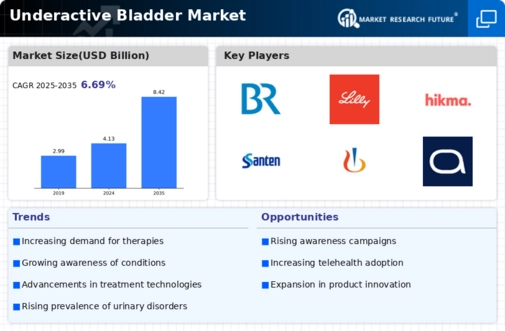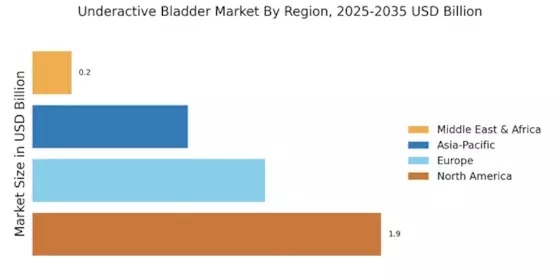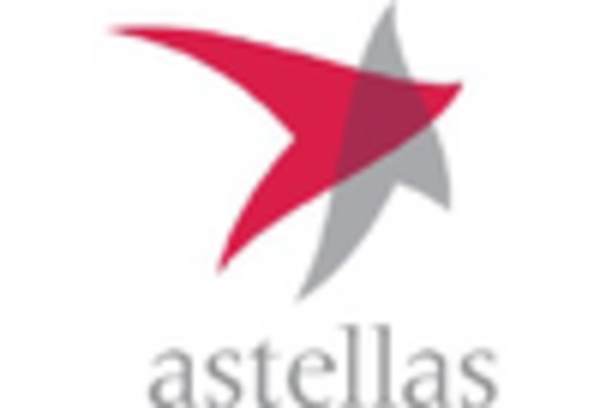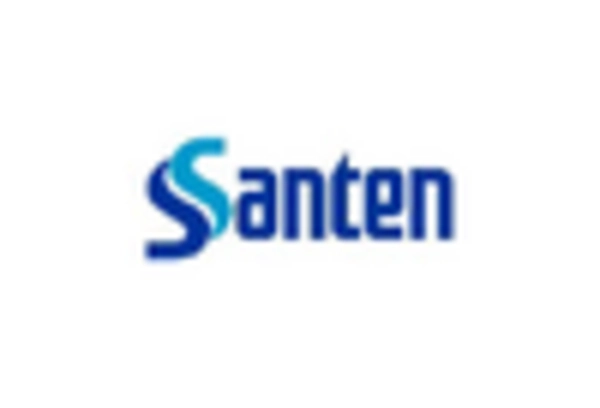Aging Population
The aging population is a primary driver of the Underactive Bladder Market. As individuals age, the prevalence of underactive bladder symptoms tends to increase, leading to a higher demand for effective treatment options. According to recent estimates, approximately 30% of older adults experience some form of bladder dysfunction, which significantly impacts their quality of life. This demographic shift is expected to continue, with projections indicating that by 2030, the number of individuals aged 65 and older will reach 1.5 billion. Consequently, the Underactive Bladder Market is likely to expand as healthcare providers seek to address the needs of this growing population through innovative therapies and management strategies.
Increased Healthcare Expenditure
Rising healthcare expenditure is another crucial driver for the Underactive Bladder Market. As countries invest more in healthcare infrastructure and services, there is a corresponding increase in the availability of treatments for underactive bladder. In many regions, healthcare spending has seen a steady rise, with some countries allocating over 10% of their GDP to healthcare. This financial commitment facilitates the development and distribution of advanced medical technologies and therapies aimed at managing underactive bladder symptoms. Furthermore, increased funding for research initiatives is likely to enhance the understanding of bladder dysfunction, thereby fostering innovation within the Underactive Bladder Market.
Growing Demand for Non-Invasive Treatments
The growing demand for non-invasive treatments is reshaping the Underactive Bladder Market. Patients increasingly prefer therapies that minimize surgical interventions and associated risks. This trend is evident in the rising popularity of pharmacological treatments and lifestyle modifications that offer effective symptom management without the need for invasive procedures. Market data suggests that non-invasive treatment options are projected to account for over 60% of the market share by 2026. As healthcare providers respond to patient preferences, the Underactive Bladder Market is likely to witness a surge in the development and marketing of non-invasive solutions.
Rising Awareness and Education Initiatives
Rising awareness and education initiatives are pivotal in driving the Underactive Bladder Market. Increased public and professional awareness about underactive bladder symptoms and their impact on daily life is leading to more individuals seeking help. Educational campaigns by healthcare organizations and advocacy groups are instrumental in reducing stigma and encouraging patients to discuss their symptoms with healthcare providers. This heightened awareness is reflected in a growing number of consultations and diagnoses, which in turn fuels demand for treatment options. As awareness continues to expand, the Underactive Bladder Market is likely to experience sustained growth, as more patients are identified and treated.
Technological Advancements in Medical Devices
Technological advancements in medical devices are significantly influencing the Underactive Bladder Market. Innovations such as neuromodulation devices and smart bladder management systems are emerging as effective solutions for patients suffering from underactive bladder. These devices leverage cutting-edge technology to enhance bladder function and improve patient outcomes. Market analysis indicates that the segment for advanced medical devices is expected to grow at a compound annual growth rate of 8% over the next five years. As these technologies become more accessible, the Underactive Bladder Market is poised for substantial growth, driven by the demand for effective and user-friendly treatment options.


















Leave a Comment